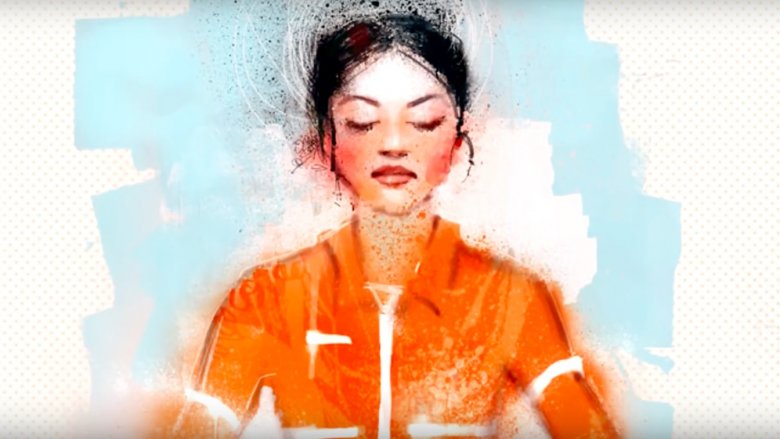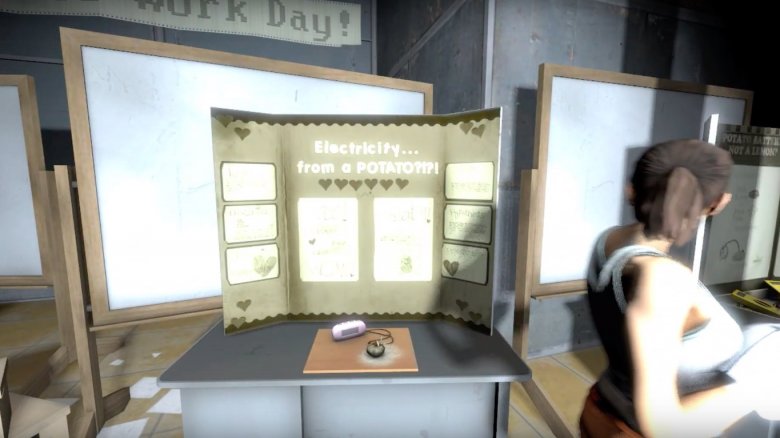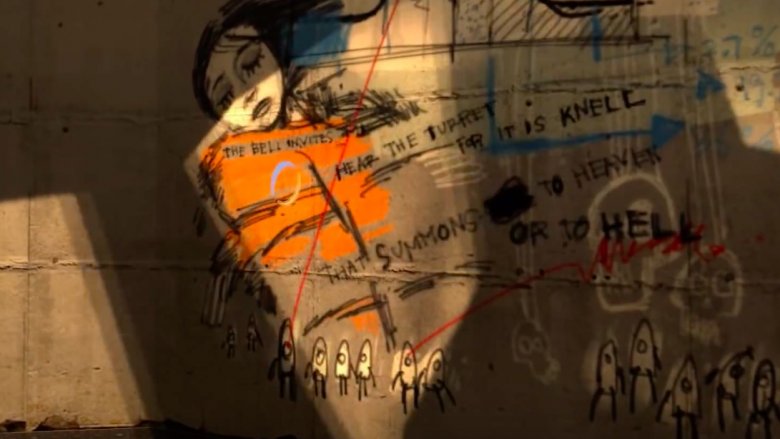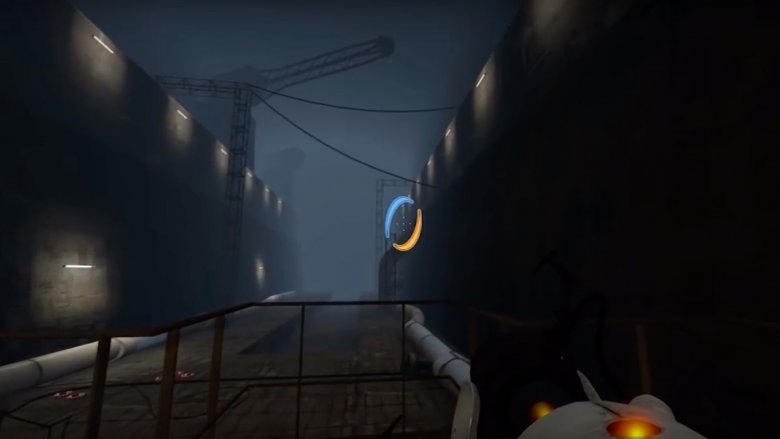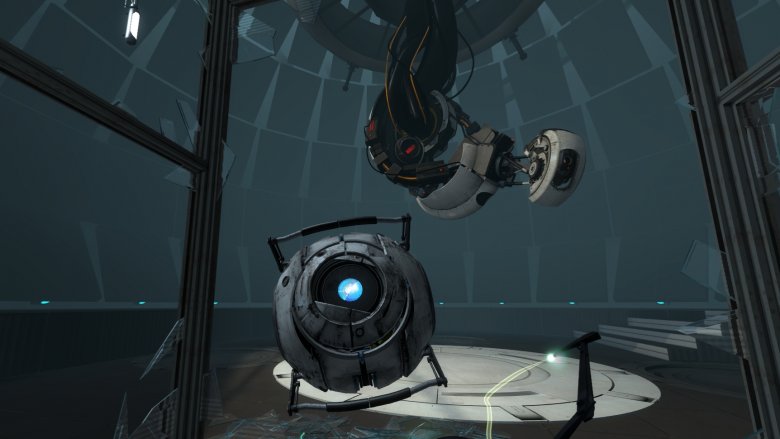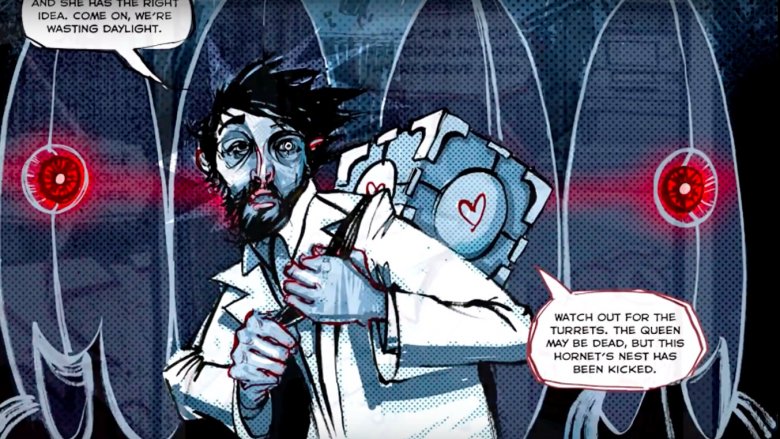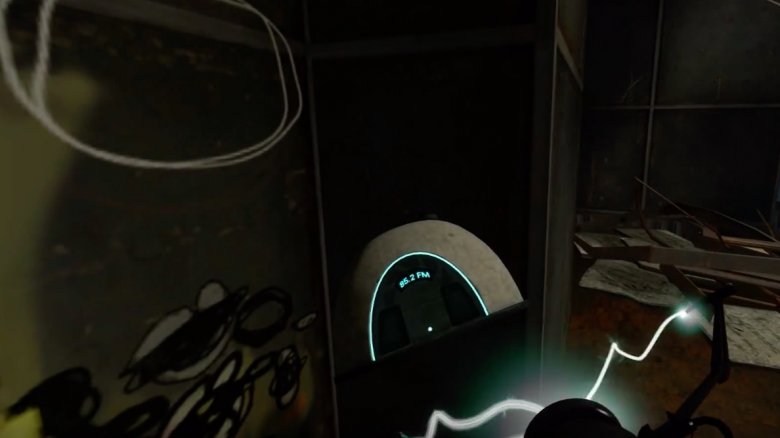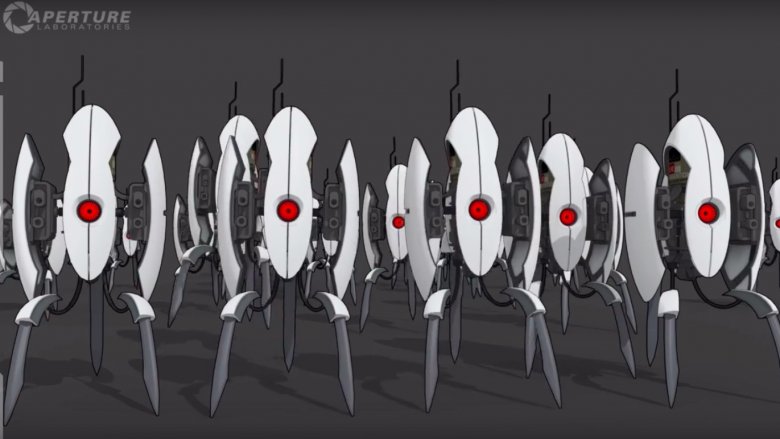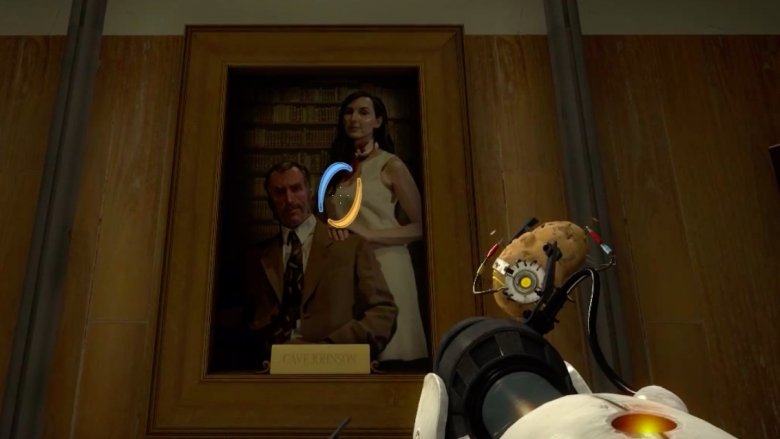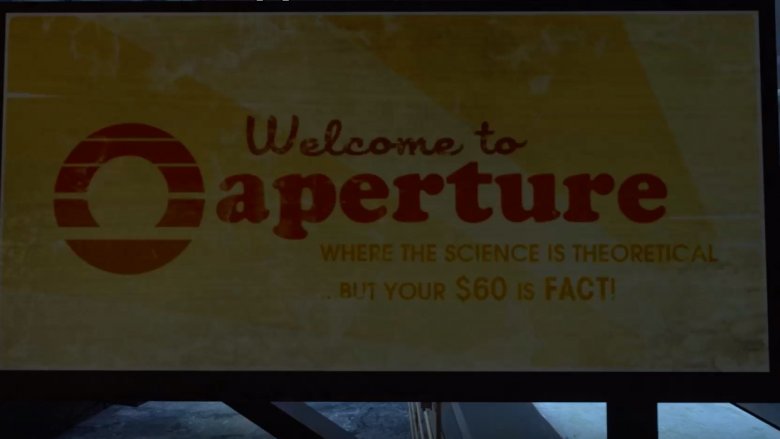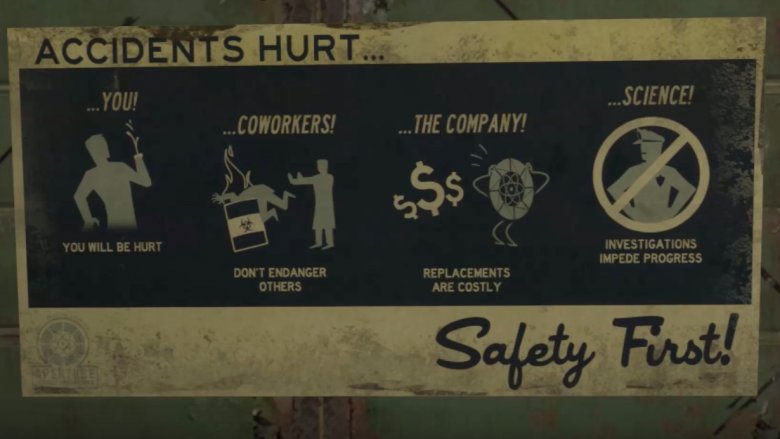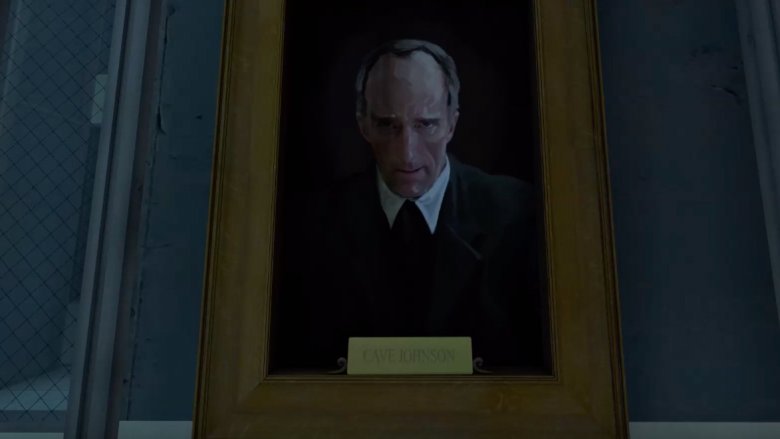Creepy Things We Found In Portal
Physics-based puzzle game Portal has been a beloved name in the Valve stable of games since its release in 2007. Being able to stand out as a fan-favorite when pitted against the wildly popular Half-Life series is a feat in and of itself. But its unique and lasting impression on the gaming community shows the staying power this quirky game holds. And while gamers are holding their breath for a sequel to the second Half-Life, they're also anxiously awaiting the announcement of a third Portal.
The Portal games are full of exciting physics puzzles and dark humor, but some of the scariest things about the story aren't immediately obvious. The lighthearted, joking tone behind the majority of the dialogue hides some seriously ominous backstories and side-stories that casual gamers may not be aware of. With everything from chilling references to other games, hidden messages, and gruesome theories about everyone's favorite Companion Cube, here are some of the creepiest things in Portal.
GLaDOS flooded Aperture with neurotoxin on "Bring Your Daughter to Work Day"
The idea that "Bring Your Daughter to Work Day" could be sinister in any way seems almost laughable. But when you work at Aperture Science, it's easy to see how this was a bad idea. As players make their way through the abandoned halls of Aperture, the overturned chairs and empty conference rooms set an eerie tone. Projectors still display meetings that were abandoned halfway through, and it's easy to imagine the panicked retreat the day GLaDOS used deadly neurotoxin to flood the Enrichment Center.
Not only did GLaDOS decide to execute employees, but she released the neurotoxin on "Bring Your Daughter to Work Day." This dark day in Aperture's history can be seen by walking through the science fair held on the day in question. While Chell observes the unsettling scene, Wheatley informs her that this well-intentioned office morale booster "did not end well." And while there's humor in his delivery of the line, the actual story is far darker than most players realize.
It gets even creepier when you realize that one of the daughters' science displays is signed "by Chell." Did Chell somehow witness, and survive, GLaDOS' massacre ... only to be imprisoned by the AI for her entire life?
You aren't as alone in Aperture as you thought
The eerie quiet that permeates Aperture Science Laboratories is unsettling. But the idea that you may not be as alone as you originally thought may be even more so. Early on, players can find hidden dens throughout the facility. Old cans of beans, water bottles, and writing on the walls all show evidence of a makeshift home. As seen in the web comic Portal 2: Lab Rat, Doug Rattmann is the former Aperture employee responsible for these aptly named Ratman dens. While his story can be pieced together in the game, the biggest chunks of lore come from the comic.
Rattmann was one of the only employees to survive when GLaDOS flooded Aperture with neurotoxin. Rattmann followed Chell around the facility during the events of Portal 1, attempting to help her defeat GLaDOS. But when Chell is dragged back into the facility at the end of the first game, Rattmann foregoes his own escape to hook Chell up to a cryo chamber in order to keep her safe. The ultimate fate of Rattmann is one of the mysteries that still haunts Portal fans to this day.
Half-Life's Borealis may be hiding in Portal's Aperture
The abandoned retro sections of Aperture are quirky and terrifying all at the same time. But when players explore locations that are out of the way of your typical gameplay, things get downright creepy. In some of the more isolated parts of Aperture, you can find several vitrified chambers. Inside one of these chambers is a huge room with a dry dock for a ship inside. The name on one of the life preserver informs you that the dry dock was created for a ship called the Borealis, which might sound familiar to fans of the Half-Life franchise.
In Half-Life 2: Episode 2, it's revealed that Aperture Science had built the Borealis as a research vessel for some "promising research." But in their haste to beat Black Mesa for funding, an accident occurred that caused the vessel and its dry dock to disappear into thin air, taking all of its crew with it. While the contents of the ship and the nature of the experiments are never explicitly stated, it is implied in an audio-log from Cave Johnson that large-scale teleportation has something to do with it.
GLaDOS has a creepy character design
Though she's often thought of as an antagonist to our main character Chell, it's no secret that GLaDOS has won over the hearts of Portal fans everywhere. From her snarky comments to her love for Cave Johnson's lemon tirade, GLaDOS is arguably the most-loved character of the franchise. While very little is known of the AI with an anger problem in the first game, more of GLaDOS' backstory is revealed throughout the story of the second.
GLaDOS is actually the consciousness of Caroline, Aperture founder Cave Johnson's assistant. And as we learn about how Caroline was forcefully placed into GLaDOS against her wishes, something else begins to come to light. GLaDOS' physical form is reminiscent of a woman hanging upside down, bound and gagged. Portal's art director Jeremy Bennett also confirmed that the character design for GLaDOS was supposed to mix Caroline's femininity and the AI's raw power. With this in mind, it's difficult to look at her without feeling a bit more sympathy than you did while dodging her attacks.
The Companion Cube is alive
One of the fan-favorite characters from the Portal franchise comes in the form of an inanimate object that doesn't interact with the character in any meaningful way. In fact, the "character" in question is a literal box with a pink heart. Much like Wilson from Tom Hanks' movie Cast Away, players found themselves attached to an inanimate object when the Companion Cube was introduced. Maybe it was because up until this point players had been completely isolated, except for a snarky AI who obviously wanted them dead.
As players interact with the Companion Cube in both the first and second Portal games, GLaDOS makes references to former test subjects thinking they can hear the cube talking to them. She also mentions that the cubes are sentient. This theme is only furthered when GLaDOS forces you to incinerate your cube in the first game. When players obey her orders, they're awarded the "fratricide" achievement. Since "fratricide" means the killing of a sibling, it's suggested that the Companion Cube wasn't as inanimate as GLaDOS first led us to believe.
The creepy radio signal in Portal 2
The many hidden dens of former Aperture employee Doug Rattmann can be found littered throughout the now-abandoned facility. And while most of them contain chilling art and messages left by Rattmann, one in particular contains something eerie. If you pick up a radio in Test Chamber 6 of Chapter 2, you'll hear a jumble of mixed radio signals. At first, these signals sound like audio filler. It seemed far-fetched that the jumble of sounds was anything important.
But knowing how deep the lore of Portal and Aperture go, fans decided to try to decode what they felt might be a secret message. When they did, fans found that the radio signals on this handheld radio actually contained an image of a Companion Cube on the moon. This can either be seen as foreshadowing for the end of the game, when Wheatley gets launched into space, or a dark message about Doug Rattmann's final fate.
A sentient turret tells you the future
Most of the adversaries within the walls of Aperture Science aren't actively trying to kill you. For much of the game, players will find themselves bested by a misplaced portal or a miscalculation in physics. But while these are the most common culprits for your character's demise, one of the few actively hostile characters in this game might actually hold a dark secret if you get the chance to listen.
While going through the laser turret redemption line in the Aperture facility, players can find a turret who, while activated, isn't targeting them. The turret even tells the player that they're "different" in an attempt to get you to save them. If you do save the turret from the incinerator, you'll be rewarded with a retelling of the story of Prometheus. The turret tells players that Prometheus was punished by the gods for giving the gift of knowledge to men and was subsequently pecked by birds. This bears an unsettling parallel to GLaDOS' fate when Wheatley takes her power and she's forced to reside in a potato, attacked by birds.
Creepy dialogue shows Caroline being forced to become GLaDOS in Portal 2
When you reach the sealed off portions of the Aperture Science Laboratories, you're treated to some entertaining insights into the early days of the company. We even hear snippets of dialogue from GLaDOS before she became an antagonistic AI. The chipper and dedicated assistant Caroline shows a totally different side of GLaDOS. But this glimpse into her past isn't all sunshine.
In the unused dialogue found in the files of Portal 2, players discovered some chilling audio clips. Snippets of Caroline's voice actress Ellen McLain can be heard explicitly stating "Mr. Johnson, I do not want this." The dialogue was part of a scene in which Caroline is forced to have her consciousness transferred into the machine that would become GLaDOS. This is already hinted at in Johnson's audio recording that tells his workers to have Caroline run the place even if she refuses. It's also been rumored that the reason we only have audio files of Caroline's side of the conversation is because Valve realized the scene could be perceived as assault, which didn't match the tone of the game.
Cave Johnson convinced the homeless to risk their lives for $60
It's no secret that the way Cave Johnson ran his testing facility was a bit less than ethical. And while his capitalist attitude may have been the very thing that helped him to succeed in the business world, it was also what led to a lot of the poor decisions made throughout his career. The slow descent from Johnson's high hopes for his company into the disheartened man he becomes towards the end of his life is tragic.
In the early days of Aperture, Cave Johnson recruited what he felt were the best of humanity to come and test his ideas. He only wanted smart and well-respected citizens to lend credibility to what he was doing. But as his tests became more dangerous, the quality of his test subjects began to dip down below his standards. Eventually, Johnson stooped to recruiting homeless people for the promise of $60. And while this is dark enough, his complete lack of respect or regard for the lives of these test subjects may be the scariest thing found in the game.
The creepy side effects of science
The tests administered on human subjects in Aperture were dangerous and unethical. But the extent of the danger wasn't explicitly obvious until you access some of the audio clips recorded by Cave Johnson. In the smattering of side-conversations and pre-recorded messages from the founder of Aperture, you begin to learn just what side effects might be in store for Chell.
The possibility of becoming some sort of super-human praying mantis creature doesn't seem like the worst thing that could happen to you, but this is probably the best-case scenario for Aperture test subjects. The abundance of tumors produced by radiation exposure, deadly effects of asbestos, and the toxic Moon rocks that eventually led to Cave Johnson's death likely claimed a good portion of the test subjects. At least with everyone else in the facility dead, players know the thing most likely to kill them is GLaDOS. But this still doesn't stop you from wishing there was a spare hazmat suit handy.
Portal shows unbridled capitalism at the expense of national safety
Many stories that involve a corrupt system falling from grace are often the result of ambitious people forgetting the value of human life. Just like Andrew Ryan's failed society in the BioShock franchise, Cave Johnson's unchecked power and ambition are what ultimately led to his demise when the Moon rocks used in his experiments proved to be toxic and eventually led to his death. But Johnson wasn't the only one to have their well-being jeopardized by his cavalier approach to rules.
Many of the experiments performed by the Aperture founder could easily be weaponized by various governments. Given the power of much of the technology found within the walls of Aperture Science Laboratories, it's easy to see how the inventions Johnson fabricated could do more harm than good if sold to the wrong party. And since his ultimate goal was to sell his inventions to anyone willing to pay, questionable power could have been given to anyone. After all, most armies would pay a lot of money for a battalion of mantis men.
